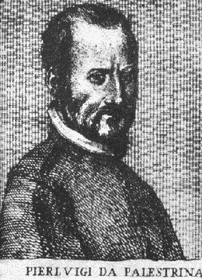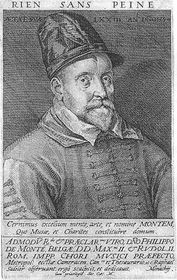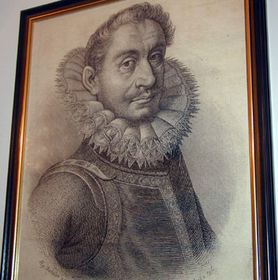
The growing emphasis on individualism during the Renaissance began a change of status for composers in society. Unlike their medieval predecessors, Renaissance composers were recognized more often during their lifetimes. The technology of printing permitted a much wider distribution of their works and enabled a larger public to study the music.
Even when spiritual music was still in a dominant position, secular music was becoming more common and its forms more cultivated than in the previous era. The repertoire of instrumental music became more varied, along with the invention of new instruments - such as the clavichord and the virginal (a keyed instrument resembling the harpsichord) - and many of the instruments of the period were improved.
Masses and motets were the main forms of spiritual vocal polyphony. Secular vocal forms included motets, madrigals, and songs (mostly accompanied by the lute or a small orchestra). The main instrumental works were short polyphonies or music for dancing.
 In comparison with medieval music, Renaissance harmony was more unrestrained and more expressive - the period between Josquin Deprez and Palestrina is known as "the golden age of polyphony." Imitation - where one musical line shares or imitates the same musical theme of the preceeding line - became an important polyphonic technique. Imitation was used to introduce complexitities by simpler means and at the same time give listeners the ability to perceive the structure of the composition. Polyphonic imitation can be heard in the masses and motets of practically all the composers beginning with Desprez, and in the instrumental music of William Byrd, Orlando Gibbons, and Andrea and Giovanni Gabrielli.
In comparison with medieval music, Renaissance harmony was more unrestrained and more expressive - the period between Josquin Deprez and Palestrina is known as "the golden age of polyphony." Imitation - where one musical line shares or imitates the same musical theme of the preceeding line - became an important polyphonic technique. Imitation was used to introduce complexitities by simpler means and at the same time give listeners the ability to perceive the structure of the composition. Polyphonic imitation can be heard in the masses and motets of practically all the composers beginning with Desprez, and in the instrumental music of William Byrd, Orlando Gibbons, and Andrea and Giovanni Gabrielli.
| Johannes Ockeghem | (1425 - 1497) |
| Josquin Desprez | (1440 - 1521 or 1524) |
| Andrea Gabrielli | (1510 - 1586) |
| Giovanni Pierluigi da Palestrina | (1525 - 1594) |
| Orlande de Lassus | (1532 - 1594) |
| William Bird | (1543 - 1623) |
| Giovanni Gabrielli | (1554 - 1612) |
| Carlo Gesualdo | (1560 - 1613) |
| John Dowland | (1563 - 1626) |
| Orlando Gibbons | (1583 - 1625) |
 Philippe de Monte
The instrumental element in church music became more significant as can be seen from many comments and illustrations in hymn books. This was under the influence of the Jesuits, and brought a renewed general appreciation of the organ. In many locations, records mention the construction of new instruments, of which the most famous was built on the instigation of the writer, courtier, warrior and diplomat, Kryštof Harant of Polžice and Bezdružice at St. Vitus Cathedral in Prague, finished in 1567 by the organ-builder from České Budějovice, Jáchym Rudner.
Philippe de Monte
The instrumental element in church music became more significant as can be seen from many comments and illustrations in hymn books. This was under the influence of the Jesuits, and brought a renewed general appreciation of the organ. In many locations, records mention the construction of new instruments, of which the most famous was built on the instigation of the writer, courtier, warrior and diplomat, Kryštof Harant of Polžice and Bezdružice at St. Vitus Cathedral in Prague, finished in 1567 by the organ-builder from České Budějovice, Jáchym Rudner.
The biggest and most important musical institution in the Czech lands was the court ensemble. Founded by Ferdinand I (1526 - 1564) as a group of singers with two organs. Under the Emperor Maximilian (1564 - 1576) several other instruments were added, and it reached its peak of development during the reign of Rudolph II. Czech membership in the group was low, as it was mostly made up of Dutch, Spaniards, Germans, and Italians. For 35 years until his death, its conductor was Philippe de Monte (1521 - 1603), a composer of masses, motets and madrigals. Following the example of the imperial court, local nobles encouraged the growth of music in their courts. In the second half of the 16th century, the Rosenberg ensemble in Krumlov gained fame under both of the last heads of the Rosenberg family, William and Peter Vok.
 Kryštof Harant of Polžice
In the first two decades of the 17th century, easily the biggest group was the one at Pecka castle. It was established by Lord Kryštof Harant of Polžice (1564 - 1621), a writer, soldier, courtier, and diplomat, who lost his head for his participation in the Czech insurrection. Among his works that survive are a six-part motet Qui confidunt in Domino, a five-part motet Maria Kron and an especially beautiful five-part mass in the Cantus Firmus Dolorosi Martyr from the popular Marenzi madrigal. There are also documented fragments of four other vocal pieces, of which the most interesting is a composition with a Czech text Dejž tobě Pán Bůh štěstí (May the Lord Give You Good Fortune).
Kryštof Harant of Polžice
In the first two decades of the 17th century, easily the biggest group was the one at Pecka castle. It was established by Lord Kryštof Harant of Polžice (1564 - 1621), a writer, soldier, courtier, and diplomat, who lost his head for his participation in the Czech insurrection. Among his works that survive are a six-part motet Qui confidunt in Domino, a five-part motet Maria Kron and an especially beautiful five-part mass in the Cantus Firmus Dolorosi Martyr from the popular Marenzi madrigal. There are also documented fragments of four other vocal pieces, of which the most interesting is a composition with a Czech text Dejž tobě Pán Bůh štěstí (May the Lord Give You Good Fortune).
The lute was developed for both solo performance and accompanying singers. In Rudolph's Prague, its master was Jan Vencálek in particular. Vocal compositions were even arranged for lute, as can be seen for example in the transcription of the German song of Regnart's, apparently sung in a Czech arrangement.
In the 16th century, more than in the 15th, a larger role was taken by popular secular Czech folk songs, such as Čížku, ptáčku zeleného peří (Siskin, bird of the green feathers), Proč kalina v struze stojí (Why does the rose grow in the ditch), Stojí lipka v širém poli (The linden stands in the open field), Dorna chodí po louce, (Dorna walks through the meadow). They were used mostly as strains in spiritual songs, and sometimes in form they also became "cantus firmus" contrapuntal compositions.
| Philippe de Monte | (1521 - 1603) |
| Jacobus Gallus | (1550 - 1591) |
| Kryštof Harant of Polžice | (1564 - 1621) |
| Jan Vencálek | (1598 - ?) |
